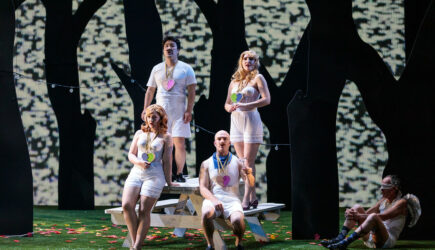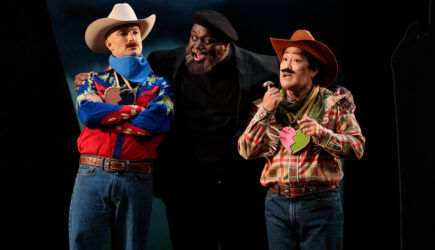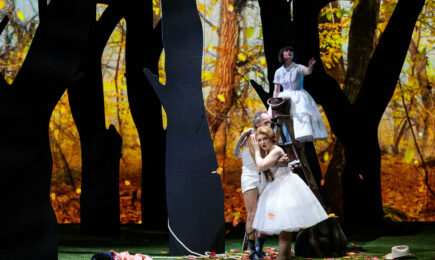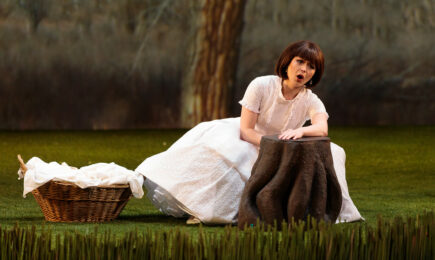Così fan tutte
Così fan tutte by Wolfgang Amadeus Mozart. Opera buffa in two acts. 1789. Libretto by Lorenzo Da Ponte. First performance at the Burgtheater, Vienna, on 16th January 1790.
Seen: Saturday, February 12, 2022. San Diego Opera. San Diego Civic Theatre. Opera Gazet reviewer: Garrett Harris.
Alisa Jordheim (Despina); Samantha Hankey (Dorabella); Sarah Tucker (Fiordiligi); John Brancy (Guglielmo); Konu Kim (Ferrando); Reginald Smith, Jr. (Don Alfonso); Jack Missett (Cupid); Bruce Stasyna (Conductor); Tim Nelson (Director)
Production: 2**
Music: 3***
This production of Mozart’s Così fan Tutte was the first fully-staged production of opera at The San Diego Civic Theatre since Humperdinck’s Hansel und Gretel in February of 2020, just before everything shut down. San Diego Opera did produce outdoor drive-up versions of La Boheme and The Barber of Seville in 2020 and 2021 respectively.
With this in mind, Saturday’s performance did not feel like much of an occasion. The attendance appeared, from where we were sitting, to be somewhat sparse.
We will say that the singers for this production were sufficient. The voices were on the small side for the 2,900 seats of the Civic Theatre but they could be heard — for the most part. The traditional approach to smallish voices is to blame the size and acoustic of the Civic Theatre. We are not here to review the size and acoustic of the Civic Theatre.

Mezzo-soprano Samantha Hankey as Dorabella and tenor Konu Kim as Ferrando stood out from the rest of the cast. Ms. Hankey’s voice was of adequate size for the house and was remarkably consistent in tone and timbre from top to bottom. Mr. Kim’s voice was well-grounded with a developing chest register which gave his upper notes a virility that is often lacking in tenors who sing Mozart.
When the curtain went up, we were surprised to see a set that was clearly designed for a much smaller stage. A raked stage with a screen for projections took up about 70 percent of the proscenium.
God of Love in dingy underwear
There were ten to fifteen feet of open space on each side of the set before the official wings of the stage. It looked like this set was wearing its uncle’s tuxedo.
The first character to appear was a personification of the God of Love. This God of Love was dressed in dingy underwear and appeared to be a member of San Diego’s notorious homeless community.
At first, we thought this figure was interesting. Perhaps this represented the broken relationships between the principal characters. Their love was a mere shadow of the real thing. We expected this character to evolve as the relationships between the characters evolved. Maybe he would show up elegantly dressed and full of energy at the end of the show. Maybe he would give his blessing to the now resilient lovers.


That didn’t happen. At the end of the show, the God of Love stowed his cupid wings in a tattered suitcase, put on a tattered overcoat, and walked offstage — to panhandle apparently.
The effective part of the God of Love character is that he provided a foil for the singers to play off during their arias and even during some of the ensemble sections. The days of a singer planting their feet downstage and delivering a vocal tour de force are, unfortunately, gone for the most part.
This production was yet another tired re-imagining of tried and true opera. The opening scene was set in a men’s locker room. The next set was a field of flowers. The program called this, “A field of possibility as the sun sets”. The Act II set was called, “A darkening forest of the mind.”
As is the case with most re-imagined productions, the concept didn’t stay consistent with itself and created a legion of incongruities between what was seen on stage and the text being sung. At one point the women decide that one of them likes the darker boy and the other likes the blonde. Ferrando had dark hair and Guglielmo had none.
This might appear as nitpicking but for too long opera productions have not been held accountable for their incongruities. What’s wrong with putting a comedic blonde wig on Guglielmo?

Don Alfonso’s character was all over the place in this production. Sometimes he was a movie director and other times he was the man in the moon looming over the scene as a projection.
We found the man in the moon idea to be quite funny and clever but it only happened once. That could have been a brilliant way to present the character throughout.
Don Alfonso had Despina film each set of lovers in their two pivotal scenes as the women acquiesce to the advances of the false men. He could have been directing the movie the entire time. That would have been an effective way to present the character. He could have been in multiple scenes physically positioning the characters for the movie he was making—framing up his next shot as he directed them toward his goal.
Instead, we got two half-baked ideas for one character. As the great Ron Swanson of TV’s Parks and Rec said, “’Never half-ass two things, whole-ass one thing.”

I was a member of San Diego Opera Company for nearly 20 years starting with the 1965-66 season. The ensemble singing was wonderful. I enjoyed the singers except for Despina–Alisa Jordheim. I couldn’t hear her. I wonder if anyone can explain to me why it was necessary to re-set the opera in the 1950’s. Dime store cowboys that looked like the eastern visitors to dude ranches in the movies of the 1930’s and 40’s. Cast members preforming most of the opera in underwear. Cupid? What was that all about? This production needs a serious re-think. What would Mozart think of… Read more »
I wanted to leave but my buddy didn’t. Wish we had. Darted out as soon as the scrim fell. Is this the death knell of SDO?! 😭😭😭🤷🏻♂️